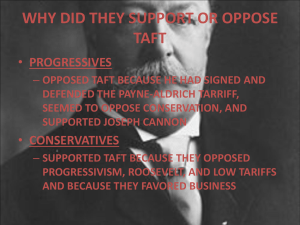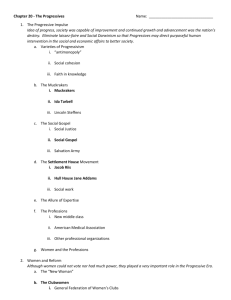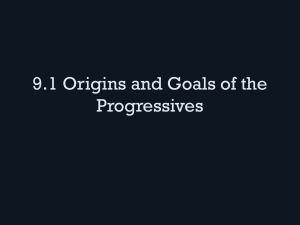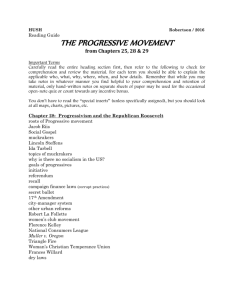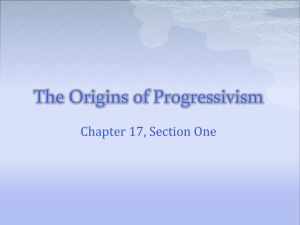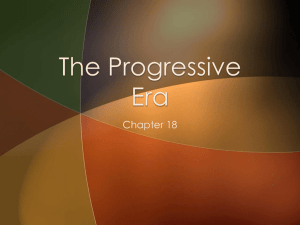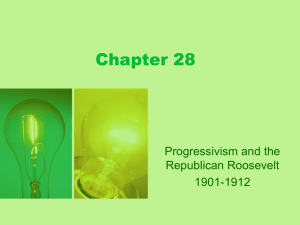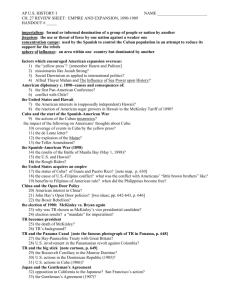Brinkley CH 22-
advertisement
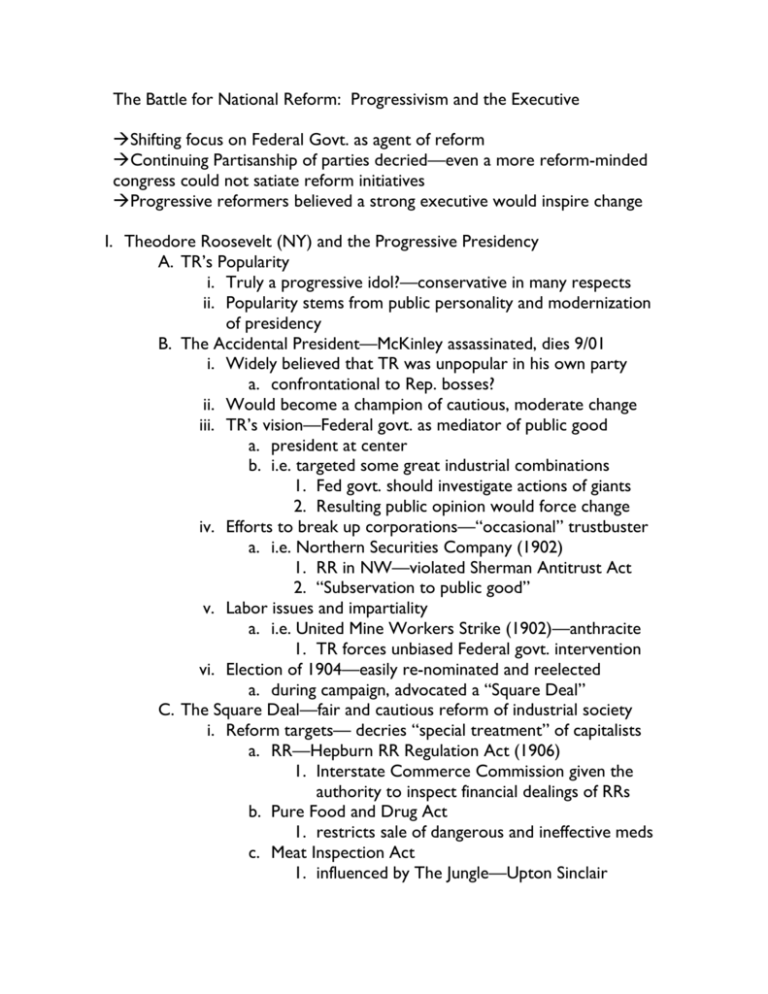
The Battle for National Reform: Progressivism and the Executive Shifting focus on Federal Govt. as agent of reform Continuing Partisanship of parties decried—even a more reform-minded congress could not satiate reform initiatives Progressive reformers believed a strong executive would inspire change I. Theodore Roosevelt (NY) and the Progressive Presidency A. TR’s Popularity i. Truly a progressive idol?—conservative in many respects ii. Popularity stems from public personality and modernization of presidency B. The Accidental President—McKinley assassinated, dies 9/01 i. Widely believed that TR was unpopular in his own party a. confrontational to Rep. bosses? ii. Would become a champion of cautious, moderate change iii. TR’s vision—Federal govt. as mediator of public good a. president at center b. i.e. targeted some great industrial combinations 1. Fed govt. should investigate actions of giants 2. Resulting public opinion would force change iv. Efforts to break up corporations—“occasional” trustbuster a. i.e. Northern Securities Company (1902) 1. RR in NW—violated Sherman Antitrust Act 2. “Subservation to public good” v. Labor issues and impartiality a. i.e. United Mine Workers Strike (1902)—anthracite 1. TR forces unbiased Federal govt. intervention vi. Election of 1904—easily re-nominated and reelected a. during campaign, advocated a “Square Deal” C. The Square Deal—fair and cautious reform of industrial society i. Reform targets— decries “special treatment” of capitalists a. RR—Hepburn RR Regulation Act (1906) 1. Interstate Commerce Commission given the authority to inspect financial dealings of RRs b. Pure Food and Drug Act 1. restricts sale of dangerous and ineffective meds c. Meat Inspection Act 1. influenced by The Jungle—Upton Sinclair d. 1907—increased measures proposed—unsuccessful 1. 8hr day, worker’s comp, new taxes, market reg 2. met w/opposition from conservative Rep. D. Roosevelt and the Environment i. Conservation—restriction of private dev. on public land a. Govts’ role as manager of dev. of wilderness b. Gifford Pinchot—National Forest Service 1. scientific conservation and renewal ii. Public reclamation and irrigation projects a. National Reclamation Act (1902) 1. Fed. $ for dams, reservoirs, canals a) lands for cultivation—cheap power iii. TR’s Naturalistic Philosophy a. Keeping lands free from human intrusion b. i.e. adding lands to National Park System c. influence of John Muir—Sierra Club founder d. Hetch Hetchy Valley fight (1906) 1. Yosemite area to be dammed a) Conservationists lose, but unite E. Panic and Retirement i. 1907 marked by serious recession a. proof that govt. still has little control over economy b. TR reassures conservatives and business leaders that govt. will not interfere with private recovery efforts ii. J.P. Morgan—financier and owner of U.S. Steel offers plan a. TN Coal and Iron—struggling bank holds shares b. Morgan would absorb company if TR would not sue c. Stabilizes banking system iii. TR promised not to seek 3rd term in 1904 a. Might not have received nomination of own party? F. Assessment of TR’s domestic presidency i. Helped shape Progressive movement ii. Expanded powers of presidency iii. Launched Square Deal II. The Troubled Succession A. William Howard Taft (OH)—handpicked by TR i. Popular among both Progressives and conservatives a. Moderate lawyer, high regard for legal process ii. Would leave office quite decisively in 1913 a. Could not match TR’s dynamic personality b. Stretched by Progressives and conservatives B. Taft and the Progressives i. Payne-Aldrich Tariff—little effect on rates a. Progressives outraged b. Taft points to separation of powers—legislation ii. Pinchot-Ballinger Controversy (1909) a. Richard A. Ballinger, a conservative corporate lawyer, named secretary of the Interior—favors development b. Charges of corruption in AL coal mines—profit c. Pinchot leaks story to press after Taft’s inaction d. Pinchot fired, committee exonerates Ballinger 1. Taft’s popularity with Progressives destroyed iii. But Taft brought 90 suits against trusts! a. Many more than TR C. The Return of Roosevelt i. Increasing critic of Taft’s actions—inactions? ii. “New Nationalism” philosophy—roots of Progressivism a. from cautious reform to demand for social justice b. strong fed govt as “steward of the public welfare c. graduated taxes, worker’s comp, reg of labor/corp. D. Spreading Insurgency i. Republicans split—progressives and conservatives a. 1910 congressional elections, Dems win big ii. TR changes his mind about seeking presidency a. Taft adm. tries to break up U.S. Steel (10/11) b. Robert La Follette WI Gov. and Sen. Loses favor E. TR v. Taft—1912 election i. TR—progressives vs. Taft—conservatives ii. “Old Guard” Republicans nominate Taft a. TR walks out—launches Progressive Party b. Many “insurgents” reluctant to abandon Rep. III. Woodrow Wilson and the New Freedom A. 1912 Election becomes a fight between two brands of reform B. Woodrow Wilson—emerges as candidate i. Scholarly governor of New Jersey—committed to reform ii. “New Freedom”—destroy monopoly, not just regulate iii. Taft basically concedes, TR cannot draw Dem progressives C. The Scholar as President i. Perhaps more than TR and Taft, Wilson strengthens pres. ii. Uses Dem majority to fulfill progressive goals a. Underwood-Simmons Tariff (1913) 1. first significant reduction since Civil War 2. introduces real competition to U.S. market? b. Graduated income tax adopted c. Reform of U.S. Banking System--Federal Reserve Act 1. 12 regional Fed Reserve banks would hold percentage of assets of individual member banks (that owned reserve banks), reserve assets used to support loans to private banks at a discount—funds easily moved to trouble 2. new paper currency issued—flexibility d. Reform of Monopolies 1. Federal Trade Commission a) Advise businesses on future actions b) Investigation of trade practices 2. Clayton Antitrust Act, diluted by conservatives a) Would have strengthened Sherman Act D. Retreat and Advance i. By end of 1914, Wilson believed “New Freedom” complete a. Does not support national suffrage b. Condones re-imposition of segregation in Fed govt. c. Dismisses many further attempts at prog. reform ii. Congressional elections of 1914—major Dem losses a. Re-forging of Republican Party iii. Second flurry of reforms: a. Louis Brandies to Supreme Court—Jew and prog. b. Expansion of credit to farmers c. Worker’s compensation for Federal employees d. Keating-Owen Act (1916) 1. bars interstate goods produced by underage 2. regulation of interstate commerce e. Heavy tax on child labor users f. Smith-Lever Act (1914) 1. grants to states that support Ag. Education IV. Evaluation of Progressivism A. Accomplishments i. Trustbusting forces industrialists to consider public opinion ii. Legislation gives fed./state govt. tools to protect public iii. Income tax helps build govt. revenues/redistribute wealth iv. Challenges traditional approaches to domestic problems B. Weaknesses of Progressivism i. Goals often confusing and contradictory ii. Opposition strong by conservatives and courts iii. Govt. still influenced by business and industry iv. WWI dampens enthusiasm for “just societies”
